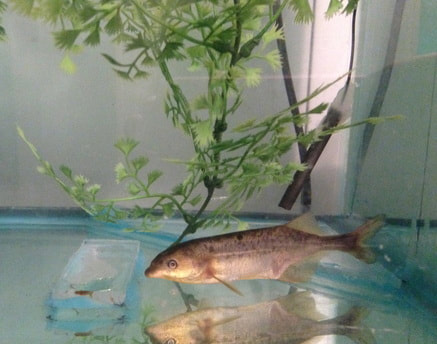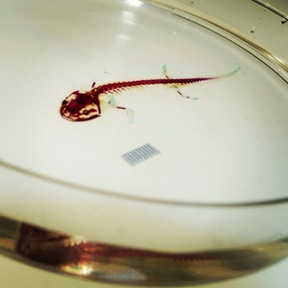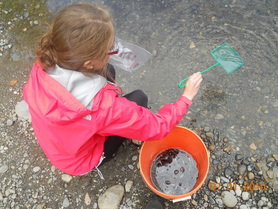Photo: Chugach State Park, Anchorage, Alaska
Past Research
McGill University
 Marcusenius victoriae
Marcusenius victoriae
PhD Research
I completed my PhD at McGill University under the co-supervision of Lauren Chapman and Rüdiger Krahe.
One of the main goals of my PhD research was to quantify potential trade-offs between swim performance and active sensing in weakly electric fishes when dissolved oxygen concentrations become limited.
Dissolved oxygen (DO) concentration is a key factor limiting the growth, reproduction, and survival of water-breathing aquatic organisms such as fishes. Low DO concentration (hypoxia) occurs when the demand for DO surpasses that available within the water. Human activities are increasing the occurrence of hypoxia on a global scale, and it is now considered to be one of the greatest threats currently facing fishes. Fishes can lessen oxygen requirements under hypoxic conditions by altering metabolically costly behaviours, such as swimming and sensory information acquisition. However, behaviours such as sensory information acquisition can be difficult to quantify. Recent work in weakly electric fishes has shown them to be a great model system for exploring energetic trade-offs related to swim performance and sensory information acquisition, as we can non-invasively quantify the aerobically-expensive electric organ discharges (EODs) they use for active acquisition of sensory information during swimming.
To do this, I measured both critical swim speed and fast-start swim performance, concurrently with EOD production, under high and low DO concentrations in several species of weakly electric fishes. I am looking at the effects of both short-term and long-term exposure to hypoxia on swimming and signalling in species from habitats with naturally divergent oxygen regimes. I am comparing responses of species from both independent lineages of weakly electric fishes to provide generally applicable conclusions about interactions among sensory information acquisition and performance, which should have relevance to a broad range of taxa and regions.
An additional goal of my PhD research is to explore the relationship between body shape and swimming performance among closely related, morphologically distinct species of African mormyrids.
Swim performance in fishes is influenced by body morphology, which is often reflective of the natural environment. For example, fish living in high-flow environments (e.g., river rapids) typically have streamlined bodies and fins designed for steady swimming, while fish from low-flow, structurally complex environments (e.g., swamps) typically have maneuverable bodies and large fins that aid in unsteady swimming. These factors can also be influenced by phylogenetic relationships among species. To obtain a comprehensive understanding of the influence of natural habitat on morphology and swimming performance, I investigated the relationship between morphology and swimming performance among four closely related species of wild-caught elephant nose mormyrid fishes from divergent habitats. I used geometric morphometrics to characterize differences in body and fin shapes among species, and compared the swimming kinematics of each species across different speeds to quantify swimming capabilities.
I completed my PhD at McGill University under the co-supervision of Lauren Chapman and Rüdiger Krahe.
One of the main goals of my PhD research was to quantify potential trade-offs between swim performance and active sensing in weakly electric fishes when dissolved oxygen concentrations become limited.
Dissolved oxygen (DO) concentration is a key factor limiting the growth, reproduction, and survival of water-breathing aquatic organisms such as fishes. Low DO concentration (hypoxia) occurs when the demand for DO surpasses that available within the water. Human activities are increasing the occurrence of hypoxia on a global scale, and it is now considered to be one of the greatest threats currently facing fishes. Fishes can lessen oxygen requirements under hypoxic conditions by altering metabolically costly behaviours, such as swimming and sensory information acquisition. However, behaviours such as sensory information acquisition can be difficult to quantify. Recent work in weakly electric fishes has shown them to be a great model system for exploring energetic trade-offs related to swim performance and sensory information acquisition, as we can non-invasively quantify the aerobically-expensive electric organ discharges (EODs) they use for active acquisition of sensory information during swimming.
To do this, I measured both critical swim speed and fast-start swim performance, concurrently with EOD production, under high and low DO concentrations in several species of weakly electric fishes. I am looking at the effects of both short-term and long-term exposure to hypoxia on swimming and signalling in species from habitats with naturally divergent oxygen regimes. I am comparing responses of species from both independent lineages of weakly electric fishes to provide generally applicable conclusions about interactions among sensory information acquisition and performance, which should have relevance to a broad range of taxa and regions.
An additional goal of my PhD research is to explore the relationship between body shape and swimming performance among closely related, morphologically distinct species of African mormyrids.
Swim performance in fishes is influenced by body morphology, which is often reflective of the natural environment. For example, fish living in high-flow environments (e.g., river rapids) typically have streamlined bodies and fins designed for steady swimming, while fish from low-flow, structurally complex environments (e.g., swamps) typically have maneuverable bodies and large fins that aid in unsteady swimming. These factors can also be influenced by phylogenetic relationships among species. To obtain a comprehensive understanding of the influence of natural habitat on morphology and swimming performance, I investigated the relationship between morphology and swimming performance among four closely related species of wild-caught elephant nose mormyrid fishes from divergent habitats. I used geometric morphometrics to characterize differences in body and fin shapes among species, and compared the swimming kinematics of each species across different speeds to quantify swimming capabilities.
Adelphi University
 Danio rerio
Danio rerio
I earned my BSc (2011) and my MSc (2013) in biology from Adelphi University in Garden City, New York, where I completed my undergraduate and masters theses under the supervision of Andrea Ward. In 2021, I was honoured as one of Adelphi's 10 Under 10 Alumni.
Undergraduate Thesis
My undergraduate work looked at the effects of developmental temperature on vertebral number in zebrafish (Danio rerio) and the subsequent effects of vertebral variation seen on burst swim performance. Previous work in fishes and amphibians has shown that developmental temperature can induce variation in vertebral number and that vertebral morphology significantly affects an individual’s swimming performance, which is a crucial aspect of its survival. I was interested in seeing how temperature-induced vertebral variation affected C-start performance, an important swimming maneuver fishes and amphibians use to escape predation. We found a significant effect of temperature on vertebral number and that vertebral number also significantly affected C-start performance in zebrafish.
Undergraduate Thesis
My undergraduate work looked at the effects of developmental temperature on vertebral number in zebrafish (Danio rerio) and the subsequent effects of vertebral variation seen on burst swim performance. Previous work in fishes and amphibians has shown that developmental temperature can induce variation in vertebral number and that vertebral morphology significantly affects an individual’s swimming performance, which is a crucial aspect of its survival. I was interested in seeing how temperature-induced vertebral variation affected C-start performance, an important swimming maneuver fishes and amphibians use to escape predation. We found a significant effect of temperature on vertebral number and that vertebral number also significantly affected C-start performance in zebrafish.
 Ambystoma mexicanum
Ambystoma mexicanum
Masters Thesis
I continued the theme of temperature-induced vertebral variation into my masters thesis by looking at the effects of developmental temperature on vertebral number and C-start performance in axolotls (Ambystoma mexicanum). Interestingly, we did not find the same relationship between developmental temperature and vertebral number in axolotls. However, we did see a significant effect of vertebral number on C-start performance, which was strongly correlated with body size and other morphological parameters. For a more in-depth look at this project, you can view the video put together by Adelphi as part of their 'Research Day' series.
For the second chapter of my masters thesis, I wanted to determine the ecological importance of the vertebral variation I had seen in zebrafish during my undergraduate thesis and to identify the selective factors behind it. To do this, I exposed populations of zebrafish with a range of vertebral numbers to native predators, needlenose garfish (Xenentodon cancila). The findings of these predator-prey trials suggest possible selective pressures that these and other aquatic ectothermic vertebrates may face as new threats arise in a rapidly changing climate.
I continued the theme of temperature-induced vertebral variation into my masters thesis by looking at the effects of developmental temperature on vertebral number and C-start performance in axolotls (Ambystoma mexicanum). Interestingly, we did not find the same relationship between developmental temperature and vertebral number in axolotls. However, we did see a significant effect of vertebral number on C-start performance, which was strongly correlated with body size and other morphological parameters. For a more in-depth look at this project, you can view the video put together by Adelphi as part of their 'Research Day' series.
For the second chapter of my masters thesis, I wanted to determine the ecological importance of the vertebral variation I had seen in zebrafish during my undergraduate thesis and to identify the selective factors behind it. To do this, I exposed populations of zebrafish with a range of vertebral numbers to native predators, needlenose garfish (Xenentodon cancila). The findings of these predator-prey trials suggest possible selective pressures that these and other aquatic ectothermic vertebrates may face as new threats arise in a rapidly changing climate.
Danio rerio Photo: Andrea Ward; Skeletal Preparation: KLA
Ambystoma mexicanum Photo & Skeletal Preparation: KLA
Ambystoma mexicanum Photo & Skeletal Preparation: KLA
University of Alaska Anchorage (UAA)
NSF Research Experience for Undergraduates (REU)
 Sorting stickleback in Benka Lake, AK
Sorting stickleback in Benka Lake, AK
I spent the summer of 2010 working with a PhD student in the lab of Frank von Hippel at UAA as part of the university's REU program. My project looked at trophic divergence in the threespine stickleback (Gasterosteus aculeatus) of Benka Lake, Alaska. Benka Lake, located in the Cook Inlet Basin of Alaska, is the only lake outside of British Columbia known to have sympatric populations of benthic and limnetic threespine stickleback. I used geometric morphometrics to compare the skull morphology of the benthic and limnetic populations and collected samples for future isotopic, toxicological, and parasitological analysis. During my summer in the von Hippel lab, I gained experience working in the field collecting stickleback from different lakes throughout Alaska, learning new techniques, and trying to see as many bears as possible while out backpacking.
Cold Spring Harbor Laboratory (CSHL)
Research Assistant
 Working in the field at CSHL
Working in the field at CSHL
I worked as a research assistant in the lab of Dave Jackson at CSHL from 2011-2012. While in the Jackson lab, I assisted in the lab by extracting and prepping DNA, running PCRs, making and running gels, and cloning. During the summer months, I spent a majority of my time out in the field assisting with the upkeep of the corn, sorting and planting seeds, and performing crosses.
